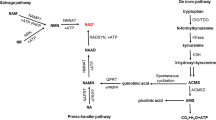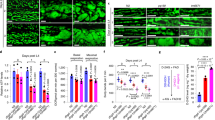Abstract
The metabolic cofactor coenzyme A (CoA) gained renewed attention because of its roles in neurodegeneration, protein acetylation, autophagy and signal transduction. The long-standing dogma is that eukaryotic cells obtain CoA exclusively via the uptake of extracellular precursors, especially vitamin B5, which is intracellularly converted through five conserved enzymatic reactions into CoA. This study demonstrates an alternative mechanism that allows cells and organisms to adjust intracellular CoA levels by using exogenous CoA. Here CoA was hydrolyzed extracellularly by ectonucleotide pyrophosphatases to 4′-phosphopantetheine, a biologically stable molecule able to translocate through membranes via passive diffusion. Inside the cell, 4′-phosphopantetheine was enzymatically converted back to CoA by the bifunctional enzyme CoA synthase. Phenotypes induced by intracellular CoA deprivation were reversed when exogenous CoA was provided. Our findings answer long-standing questions in fundamental cell biology and have major implications for the understanding of CoA-related diseases and therapies.
This is a preview of subscription content, access via your institution
Access options
Subscribe to this journal
Receive 12 print issues and online access
$259.00 per year
only $21.58 per issue
Buy this article
- Purchase on Springer Link
- Instant access to full article PDF
Prices may be subject to local taxes which are calculated during checkout






Similar content being viewed by others
References
Baddiley, J., Thain, E.M., Novelli, G.D. & Lipmann, F. Structure of coenzyme A. Nature 171, 76 (1953).
Strauss, E. Coenzyme A biosynthesis and enzymology. in Comprehensive Natural Products II (eds. Liu, H.-W. & Mander, L.) 351–410 (Elsevier, 2010).
Shi, L. & Tu, B.P. Acetyl-CoA induces transcription of the key G1 cyclin CLN3 to promote entry into the cell division cycle in Saccharomyces cerevisiae. Proc. Natl. Acad. Sci. USA 110, 7318–7323 (2013).
Siudeja, K. et al. Impaired coenzyme A metabolism affects histone and tubulin acetylation in Drosophila and human cell models of pantothenate kinase associated neurodegeneration. EMBO Mol. Med. 3, 755–766 (2011).
Takahashi, H., McCaffery, J.M., Irizarry, R.A. & Boeke, J.D. Nucleocytosolic acetyl-coenzyme A synthetase is required for histone acetylation and global transcription. Mol. Cell 23, 207–217 (2006).
Choudhary, C. et al. Lysine acetylation targets protein complexes and co-regulates major cellular functions. Science 325, 834–840 (2009).
Eisenberg, T. et al. Nucleocytosolic depletion of the energy metabolite acetyl-coenzyme A stimulates autophagy and prolongs lifespan. Cell Metab. 19, 431–444 (2014).
Mariño, G. et al. Regulation of autophagy by cytosolic acetyl-coenzyme A. Mol. Cell 53, 710–725 (2014).
McCoy, F. et al. Metabolic activation of CaMKII by coenzyme A. Mol. Cell 52, 325–339 (2013).
Srinivasan, B. & Sibon, O.C. Coenzyme A, more than 'just' a metabolic cofactor. Biochem. Soc. Trans. 42, 1075–1079 (2014).
Hoagland, M.B. & Novelli, G.D. Biosynthesis of coenzyme A from phospho-pantetheine and of pantetheine from pantothenate. J. Biol. Chem. 207, 767–773 (1954).
Bosveld, F. et al. De novo CoA biosynthesis is required to maintain DNA integrity during development of the Drosophila nervous system. Hum. Mol. Genet. 17, 2058–2069 (2008).
Daugherty, M. et al. Complete reconstitution of the human coenzyme A biosynthetic pathway via comparative genomics. J. Biol. Chem. 277, 21431–21439 (2002).
Kupke, T., Hernandez-Acosta, P. & Culianez-Macia, F.A. 4′-phosphopantetheine and coenzyme A biosynthesis in plants. J. Biol. Chem. 278, 38229–38237 (2003).
Zhyvoloup, A. et al. Molecular cloning of CoA synthase. The missing link in CoA biosynthesis. J. Biol. Chem. 277, 22107–22110 (2002).
Shimizu, S., Kubo, K., Tani, Y. & Ogata, K. Purification and properties of pantothenate kinase from Brevibacterium ammoniagenes IFO 12071. Biosci. Biotechnol. Biochem. 37, 2863–2870 (1973).
Dusi, S. et al. Exome sequence reveals mutations in CoA synthase as a cause of neurodegeneration with brain iron accumulation. Am. J. Hum. Genet. 94, 11–22 (2014).
Zhou, B. et al. A novel pantothenate kinase gene (PANK2) is defective in Hallervorden-Spatz syndrome. Nat. Genet. 28, 345–349 (2001).
Rana, A. et al. Pantethine rescues a Drosophila model for pantothenate kinase-associated neurodegeneration. Proc. Natl. Acad. Sci. USA 107, 6988–6993 (2010).
Brunetti, D. et al. Pantethine treatment is effective in recovering the disease phenotype induced by ketogenic diet in a pantothenate kinase-associated neurodegeneration mouse model. Brain 137, 57–68 (2014).
Wittwer, C.T., Gahl, W.A., Butler, J.D., Zatz, M. & Thoene, J.G. Metabolism of pantethine in cystinosis. J. Clin. Invest. 76, 1665–1672 (1985).
Zhang, Y.M. et al. Chemical knockout of pantothenate kinase reveals the metabolic and genetic program responsible for hepatic coenzyme A homeostasis. Chem. Biol. 14, 291–302 (2007).
Shibata, K., Nakai, T. & Fukuwatari, T. Simultaneous high-performance liquid chromatography determination of coenzyme A, dephospho-coenzyme A, and acetyl-coenzyme A in normal and pantothenic acid-deficient rats. Anal. Biochem. 430, 151–155 (2012).
Novelli, G.D., Schmetz, F.J. Jr. & Kaplan, N.O. Enzymatic degradation and resynthesis of coenzyme A. J. Biol. Chem. 206, 533–545 (1954).
Reilly, S.J., Tillander, V., Ofman, R., Alexson, S.E. & Hunt, M.C. The nudix hydrolase 7 is an Acyl-CoA diphosphatase involved in regulating peroxisomal coenzyme A homeostasis. J. Biochem. 144, 655–663 (2008).
Shibata, K., Gross, C.J. & Henderson, L.M. Hydrolysis and absorption of pantothenate and its coenzymes in the rat small intestine. J. Nutr. 113, 2107–2115 (1983).
Skrede, S. The degradation of CoA: subcellular localization and kinetic properties of CoA- and dephospho-CoA pyrophosphatase. Eur. J. Biochem. 38, 401–407 (1973).
Trams, E.G., Stahl, W.L. & Robinson, J. Formation of S-acyl pantetheine from acyl-coenzyme A by plasma membranes. Biochim. Biophys. Acta 163, 472–482 (1968).
Fernandez, N.J. & Kidney, B.A. Alkaline phosphatase: beyond the liver. Vet. Clin. Pathol. 36, 223–233 (2007).
McLennan, A.G. The Nudix hydrolase superfamily. Cell. Mol. Life Sci. 63, 123–143 (2006).
Rücker, B. et al. Biochemical characterization of ecto-nucleotide pyrophosphatase/phosphodiesterase (E-NPP, E.C. 3.1.4.1) from rat heart left ventricle. Mol. Cell. Biochem. 306, 247–254 (2007).
Jansen, S. et al. Structure of NPP1, an ectonucleotide pyrophosphatase/phosphodiesterase involved in tissue calcification. Structure 20, 1948–1959 (2012).
AbdelRaheim, S.R. & McLennan, A.G. The Caenorhabditis elegans Y87G2A.14 Nudix hydrolase is a peroxisomal coenzyme A diphosphatase. BMC Biochem. 3, 5 (2002).
Grobben, B. et al. Ecto-nucleotide pyrophosphatase modulates the purinoceptor-mediated signal transduction and is inhibited by purinoceptor antagonists. Br. J. Pharmacol. 130, 139–145 (2000).
Gu, X. et al. A new fluorometric turn-on assay for alkaline phosphatase and inhibitor screening based on aggregation and deaggregation of tetraphenylethylene molecules. Analyst 138, 2427–2431 (2013).
Mensch, J. et al. Evaluation of various PAMPA models to identify the most discriminating method for the prediction of BBB permeability. Eur. J. Pharm. Biopharm. 74, 495–502 (2010).
Rubio, S., Whitehead, L., Larson, T.R., Graham, I.A. & Rodriguez, P.L. The coenzyme A biosynthetic enzyme phosphopantetheine adenylyltransferase plays a crucial role in plant growth, salt/osmotic stress resistance, and seed lipid storage. Plant Physiol. 148, 546–556 (2008).
Horie, S., Isobe, M. & Suga, T. Changes in CoA pools in hepatic peroxisomes of the rat under various conditions. J. Biochem. 99, 1345–1352 (1986).
Jackowski, S. & Rock, C.O. Metabolism of 4′-phosphopantetheine in Escherichia coli. J. Bacteriol. 158, 115–120 (1984).
Davaapil, H., Tsuchiya, Y. & Gout, I. Signalling functions of coenzyme A and its derivatives in mammalian cells. Biochem. Soc. Trans. 42, 1056–1062 (2014).
Manolopoulos, P. et al. Acyl derivatives of coenzyme A inhibit platelet function via antagonism at P2Y1 and P2Y12 receptors: a new finding that may influence the design of anti-thrombotic agents. Platelets 19, 134–145 (2008).
Skrede, S. & Halvorsen, O. Mitochondrial biosynthesis of coenzyme A. Biochem. Biophys. Res. Commun. 91, 1536–1542 (1979).
Rhee, H.W. et al. Proteomic mapping of mitochondria in living cells via spatially restricted enzymatic tagging. Science 339, 1328–1331 (2013).
Leonardi, R., Rock, C.O., Jackowski, S. & Zhang, Y.M. Activation of human mitochondrial pantothenate kinase 2 by palmitoylcarnitine. Proc. Natl. Acad. Sci. USA 104, 1494–1499 (2007).
Fiermonte, G., Paradies, E., Todisco, S., Marobbio, C.M. & Palmieri, F. A novel member of solute carrier family 25 (SLC25A42) is a transporter of coenzyme A and adenosine 3′,5′-diphosphate in human mitochondria. J. Biol. Chem. 284, 18152–18159 (2009).
Moolman, W.J., de Villiers, M. & Strauss, E. Recent advances in targeting coenzyme A biosynthesis and utilization for antimicrobial drug development. Biochem. Soc. Trans. 42, 1080–1086 (2014).
Saliba, K.J. & Spry, C. Exploiting the coenzyme A biosynthesis pathway for the identification of new antimalarial agents: the case for pantothenamides. Biochem. Soc. Trans. 42, 1087–1093 (2014).
Mandel, A.L., La Clair, J.J. & Burkart, M.D. Modular synthesis of pantetheine and phosphopantetheine. Org. Lett. 6, 4801–4803 (2004).
Acknowledgements
This work was supported by the European Commission's Seventh Framework Programme (grant number FP7/2007-2013, HEALTH-F2-2011, grant agreement number 277984, TIRCON to V.T., H.P., S.H. and O.C.M.S.), a GUIDE research school grant (to B.S.), a VICI grant (NWO-grant 865.10.012 to O.S.) and Telethon GGP11088 (to V.T.). Part of the work was performed at the UMCG Microscopy and Imaging Center (UMIC), which is sponsored by NWO grant 175-010-2009-023. We thank P.G. Tepper and R. Van Merkerk (Pharmaceutical Biology, University of Groningen) for providing HPLC technical assistance and J.-W. Kok and D. Hoekstra (Department of Cell Biology, UMCG) for helpful discussions. We also thank T. de Boer and F. Oostebring from the Analytical Biochemical Laboratory BV (ABL, Assen, the Netherlands) for mass spectrometry analysis. We are grateful to the PKAN patients and their families who contributed samples to this study.
Author information
Authors and Affiliations
Contributions
B.S., M.B., R.A.L., G.K., H.P., S.H., V.T. and O.C.M.S. designed the research. B.S., M.B., M.v.d.Z., B.K., C.C., R.A.L., O.S., A.P. and N.A.G. performed experiments. B.S., M.B., R.A.L. and O.C.M.S. analyzed results. E.A.A.N., G.K., H.P., S.H., V.T., D.-J.R., N.A.G. and O.C.M.S. supervised the research. B.S., N.A.G. and O.C.M.S. wrote the manuscript.
Corresponding author
Ethics declarations
Competing interests
B.S., O.C.M.S., G.K., H.P. and A.P. are co-inventors on European patent application EP 2 868 662 A1. B.S., O.C.M.S., G.K. and H.P. are co-inventors on Slovenian patent application P-201400452. B.S., O.C.M.S., G.K., H.P. and S.H. are co-inventors on European patent application EP 15468006.0. H.P. and G.K. are shareholders in Acies Bio, Ltd.
Supplementary information
Supplementary Text and Figures
Supplementary Results, Supplementary Figures 1–16 and Supplementary Note. (PDF 7615 kb)
Rights and permissions
About this article
Cite this article
Srinivasan, B., Baratashvili, M., van der Zwaag, M. et al. Extracellular 4′-phosphopantetheine is a source for intracellular coenzyme A synthesis. Nat Chem Biol 11, 784–792 (2015). https://doi.org/10.1038/nchembio.1906
Received:
Accepted:
Published:
Issue Date:
DOI: https://doi.org/10.1038/nchembio.1906
This article is cited by
-
Probing coenzyme A homeostasis with semisynthetic biosensors
Nature Chemical Biology (2023)
-
Ischemia promotes acyl-CoAs dephosphorylation and propionyl-CoA accumulation
Metabolomics (2023)
-
Pantothenate biosynthesis is critical for chronic infection by the neurotropic parasite Toxoplasma gondii
Nature Communications (2022)
-
PI3K drives the de novo synthesis of coenzyme A from vitamin B5
Nature (2022)
-
Mitohormesis reprogrammes macrophage metabolism to enforce tolerance
Nature Metabolism (2021)



